Gen. David Petraeus takes over in Afghanistan: Will it make a difference?
Loading...
| Washington
Gen. Stanley McChrystal, the top US military commander in Afghanistan until today, has been dismissed from his post by President Obama. Will that affect the operations of American troops on the ground?
It doesn’t look as if it will, at least for now.
In announcing the McChrystal firing, Obama emphasized that he remains committed to the current strategy, which calls for a bump-up in US personnel in Afghanistan this year. And Central Command chief Gen. David Petraeus – the man Obama picked to replace McChrystal – literally wrote the manual on counterinsurgency techniques which US commanders in Afghanistan have been following.
IN PICTURES: Controversial American generals
Petraeus was a surprise choice, in the sense that as head of a combatant command he was McChrystal’s boss, and thus the Afghanistan job represents something of a demotion.
But as the general widely credited for turning around the dire situation in Iraq, he is respected by lawmakers of both parties. His presence in Kabul may allow the Obama team in Washington to put the McChrystal incident behind it more quickly than it would have otherwise.
“The Petraeus choice is an awfully good move,” says William Martel, a security studies expert at Tufts University’s Fletcher School.
McChrystal’s firing was done quickly – the general had a few minutes with Obama in the morning, then left prior to the beginning of the monthly White House meeting on Afghanistan and Pakistan policy. In announcing the move Obama stressed that it stemmed only from the general’s behavior in speaking too loosely to a reporter from Rolling Stone magazine, and not from any differences in policy.
Obama said he remained in “full agreement” with McChrystal’s approach to fighting the difficult Afghan conflict.
Winning hearts and minds
McChrystal, a former chief of Special Operations Command, did not get the Afghanistan post in the first place by being a conventional general. Instead, he emphasized a counterinsurgency doctrine that holds among other things that the strategically crucial high ground in the war is the hearts and minds of the Afghan people as much as the mountain ridges along the border with Pakistan.
McChrystal calls his approach “population-centric.” Among other things, it involves less use of close air support to bolster US ground troops when they take fire. This has reduced Afghan civilian casualties, but increased worries among junior officers about the risks they and their patrols must take.
“A year ago, close air support was a leading cause of civilian casualties, and we focused on that. And today it’s down, and Afghans see that,” said McChrystal at a June 10 roundtable discussion on the war.
McChrystal’s approach was not all peace meetings with local elders, however. At the roundtable he said that special operations forces in Afghanistan have tripled over the past year.
“In the past 90 days we’ve captured or killed 121 Taliban leaders around the country,” he said. “Now even in a population-centric [counterinsurgency] campaign you must ... target key enemy leaders.”
The strategic priority of the US Afghanistan policy is the development of the Afghan national army and police to the point where they can take control of their own country, McChrystal told reporters in May during a visit to the White House briefing room. The operational priority is securing southern Afghanistan, an area that includes Kandahar, the spiritual center of the Taliban, and Helmand, an economic wellspring for the insurgents.
Petraeus helped craft Afghanistan strategy
All of this will almost certainly continue under Gen. Petraeus, along with the surge of an additional 30,000 troops, all aimed at stabilizing the country enough to allow Obama to consider beginning troop withdrawals in July 2011. After all, Petraeus, as McChrystal’s boss, helped conceive of the strategy and draw up plans for its implementation. Yet as Petraeus himself cautioned in a congressional appearance this month, the way ahead remains rocky.
“None of this is easy or without considerable challenges,” Petraeus told the Senate Armed Services Committee on June 15.
Violence is up, the Afghan police and army remain question marks, Afghan president Hamid Karzai is seen by much of the population as corrupt, and US officials have continued to quarrel among themselves about the conduct of the Afghan operation – and whether it is even something that is crucial to US national security.
“The US has no enduring reason to maintain a strategic presence in Afghanistan or Central Asia. It has far more important strategic priorities in virtually every other part of the world,” said Anthony Cordesman, an expert on strategy at the Center for Strategic and International Studies, in a recent report that examined the case for the Afghan war.
IN PICTURES: Controversial American generals
Related:
In replacing McChrystal with Gen. David Petraeus, Obama reasserts authority
McChrystal Rolling Stone remarks spotlight Afghanistan withdrawal timeline





